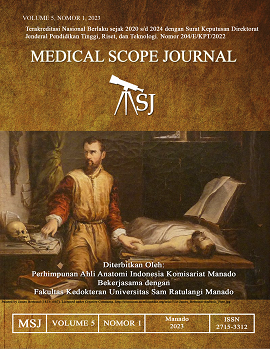Analisis Penerapan Sasaran Keselamatan Pasien di Instalasi Gawat Darurat Rumah Sakit X Provinsi Sulawesi Utara
DOI:
https://doi.org/10.35790/msj.v5i1.48229Abstract
Abstract: Patient safety is the cornerstone of health service quality and a top priority in providing health services worldwide. This study was aimed to obtain an overview of the implementation of patient safety goals at the Emergency Department of X Hospital, North Sulawesi Province. This was a qualitative study carried out at the Emergency Department of X Hospital, North Sulawesi Province from November 2022 to January 2023. The research instruments were the researchers themselves (human instruments). The results showed that the understanding of health workers about patient safety goals (SKP 1-3, 5, 6) at the Emergency Department of X Hospital and the availability of facilities and infrastructure supporting its implementation were in accordance with hospital accreditation standards of the Ministry of Health of the Republic of Indonesia 2022 but they were not optimal, therefore, the implementation of patient safety goals was also not optimal. Moreover, the related facilities and infrastructure of SKP 4 were not yet optimal. In conclusion, the patient safety goals at the Emergency Department of X Hospital North Sulawesi Province have been implemented in accordance with the hospital accreditation standards of the Ministry of Health of the Republic of Indonesia 2022 but are not optimal due to the obstacles in health workers’ compliance. The related facilities and infrastructure are not yet optimal since the new hospital has just begun to operate.
Keywords: patient safety goals; health workers; Emergency Department
Abstrak: Keselamatan pasien merupakan landasan kualitas pelayanan kesehatan dan prioritas utama dalam memberikan pelayanan kesehatan di seluruh dunia. Penelitian ini bertujuan untuk memberikan gambaran penerapan sasaran keselamatan pasien di Instalasi Gawat Darurat (IGD) RS X Provinsi Sulawesi Utara. Jenis penelitian ialah kualitatif yang dilakukan di IGD RS X Provinsi Sulawesi Utara pada bulan November 2022-Januari 2023. Instrumen penelitian yang digunakan ialah peneliti sendiri (human instrument). Hasil penelitian mendapatkan bahwa pemahaman tenaga kesehatan mengenai Sasaran Keselamatan Pasien (SKP 1–3, 5, 6) di IGD RS X Provinsi Sulawesi serta ketersediaan sarana dan prasarana yang mendukung pelaksanaannya sudah sesuai dengan standar akreditasi Rumah Sakit Kementerian Kesehatan RI tahun 2022 tetapi belum optimal sehingga penerapan SKP belum optimal. Sarana dan prasarana pendukung pelaksanaan SKP 4 di IGD masih dalam pemenuhan sesuai standar yang ditetapkan. Simpulan penelitian ini ialah sasaran keselamatan pasien di IGD RS X Provinsi Sulawesi Utara sudah diterapkan sesuai standar akreditasi rumah sakit Kementerian Kesehatan RI 2022 tetapi belum optimal karena adanya kendala pada kepatuhan petugas. Sarana dan prasarana terkait belum optimal dan masih dalam proses melengkapi karena rumah sakit baru beroperasi.
Kata kunci: sasaran keselamatan pasien; petugas kesehatan; Instalasi Gawat Darurat
References
Chief Medical Officer. An Organisation with a Memory. London: The Stationery Office; 2000.
Peraturan Menteri Kesehatan Republik Indonesia Nomor 11 Tahun 2017 tentang Keselamatan Pasien.
Peraturan Menteri Kesehatan Republik Indonesia Nomor 1691/Menkes/Per/VIII/2011 tentang Keselamatan Pasien Rumah Sakit.
WHO Patient Safety. Nine Life-Saving Patient Safety Solutions. Washington; 2007.
Joint Commission on Accreditation of Health Organizations. Hospital Patient Safety Standards (4th ed). Illinois; The Joint Commision; 2013. Available from: https://www. jointcommission.org/standards/
Anggraeni D, Hakim L, Widjiati C. Evaluasi pelaksanaan sistem identifikasi pasien di Instalasi Rawat Inap Rumah Sakit. Jurnal Kedokteran Brawijaya. 2014;28(1):99-104.
Irwanti F, Guspianto, Solida A. Hubungan komunikasi efektif dengan pelaksanaan budaya keselamatan pasien di RSUD Raden Mattaher Provinsi Jambi. Jurnal Kesmas Jambi. 2022;6(1):32-41.
Tampubolon L, Pujiyanto P. Analisis penerapan prinsip keselamatan pasien dalam pemberian obat terhadap terjadinya medication error di Rawat Inap Rumah Sakit X Tahun 2018. Jurnal ARSI. 2018;4(3):173-83.
Retnaningsih D, Fatmawati D. Beban kerja perawat terhadap implementasi patient safety di Ruang Rawat Inap. Jurnal Keperawatan Soedirman. 2016;11(1):44-52.
Amelia RA, Winarto, Hadi P, Lestari ES. Kepatuhan cuci tangan petugas rawat inap di Rumah Sakit Nasional Diponegoro Semarang. Jurnal Kedokteran Diponegoro. 2020;9(3):301-12.
Novilolita D. Analisis penyebab insiden pasien jatuh di bangsal Penyakit Dalam dan Instalasi Paviliun Ambun Pagi RSUP DR. M. Djamil Padang [Tesis]. Padang: Universitas Andalas; 2020.
Asmirajanti M, Aliyupiudin Y, Rusmini S, Rumondang PR, Chanafie D, Supyono. Penerapan standar akreditasi terhadap mutu dan keselamatan pasien sebelum dan selama pandemi Covid-19. Journal of Hospital Accreditation. 2021;3(2):65-70.
Bea IF, Pasinringi SA, Noor NB. Gambaran budaya keselamatan pasien di Rumah Sakit Universitas Hasanuddin tahun 2013. Jurnal FKM UNHAS. 2013;1-14
Setiowati D. Hubungan kepemimpinan efektif head nurse dengan penerapan budaya keselamatan pasien oleh perawat pelaksana di RSUPN Dr. Cipto Mangunkusumo Jakarta [Tesis]. Jakarta: Universitas Indonesia; 2010.
Downloads
Published
How to Cite
Issue
Section
License
Copyright (c) 2023 Astryd Sendoh, Junita M. Pertiwi, Jeanette I. Ch. Manoppo

This work is licensed under a Creative Commons Attribution-NonCommercial 4.0 International License.
COPYRIGHT
Authors who publish with this journal agree to the following terms:
Authors hold their copyright and grant this journal the privilege of first publication, with the work simultaneously licensed under a Creative Commons Attribution License that permits others to impart the work with an acknowledgment of the work's origin and initial publication by this journal.
Authors can enter into separate or additional contractual arrangements for the non-exclusive distribution of the journal's published version of the work (for example, post it to an institutional repository or publish it in a book), with an acknowledgment of its underlying publication in this journal.
Authors are permitted and encouraged to post their work online (for example, in institutional repositories or on their website) as it can lead to productive exchanges, as well as earlier and greater citation of the published work (See The Effect of Open Access).










